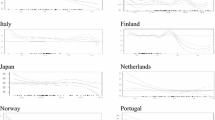Abstract
Recently various exchange rate models capturing the dynamics during the transition from an exchange rate arrangement of floating rates into a currency union have been derived. Technically, these stochastic equilibrium models are diffusion processes which have to be estimated by discretely sampled observations. Using daily exchange rate data prior to the Greek EMU-entrance on 1 January 2001, we develop a rigorous estimation procedure. Our estimates point to an increasing interventionist economic policy in the run-up to the Greek EMU entrance. A comparison of this econometric indication with policy information provided (ex-post) by the Bank of Greece (BoG) in its Annual Report 2000 reveals that the BoG indeed pursued such an active policy stance (so-called institutional frontloading strategies).
Similar content being viewed by others
References
Ait-Sahalia Y (1996) Testing continuous-time models of the spot interest rate. Rev Finan Stud 9:385–426
Ait-Sahalia Y (2002) Maximum likelihood estimation of discretely sampled diffusions: a closed-form approximation approach. Econometrica 70:223–262
Antzoulatos AA, Wilfling B (2003) Exchange and interest rates prior to EMU: the case of Greece. HWWA Discussion Paper No. 244, Hamburg Institute of International Economics (HWWA), Hamburg
Bank of Greece (2001) Annual report 2000. Athens, Greece
Bertola G (1994) Continuous-time models of exchange rates and intervention. In: Van der Ploeg F (ed) The handbook of international macroeconomics. Blackwell, Cambridge, pp 251–298
Bertola G, Caballero RJ (1992) Sustainable intervention policies and exchange rate dynamics. In: Krugman P, Miller M (eds) Exchange rate targets and currency bands. Cambridge University Press, Cambridge, pp 186–206
Brennan M, Schwartz E (1979) A continuous-time approach to the pricing of bonds. J Banking Finance 3:133–155
Campbell JY, Lo AW, MacKinlay AC (1997) The econometrics of financial markets. Princeton University Press, Princeton
Čársky R, Klačanská M, Tvarošková, A (2003) The exchange rate and its role in the EMU accession process—institutional aspects of convergence criteria of the exchange rate in the framework of EMU. BIATEC (Banking Journal of the National Bank of Slovakia), XI/8:6–9
Chan KC, Karolyi GA, Longstaff FA, Sanders AB (1992) An empirical comparison of alternative models of the short term interest rate. J Finance 47:1209–1227
Cox JC, Ingersoll JE, Ross SA (1985) A theory of the term stucture of interest rates. Econometrica 53:385–407
Darolles S, Gourieroux C (2001) Truncated dynamics and estimation of diffusion equations. J Econometrics 102:1–22
De Grauwe P (1996) How to fix conversion rates at the start of EMU. CEPR Discussion Paper No. 1530, London
De Grauwe P, Dewachter H, Veestraeten D (1999) Price dynamics under stochastic process switching: some extensions and an application to EMU. J Int Money Finance 18:195–224
Delgado F, Dumas D (1992) Target zones, broad and narrow. In: Krugman P, Miller M (eds) Exchange rate targets and currency bands. Cambridge University Press, Cambridge, pp 35–56
Elerian OS, Chib S, Shephard N (2001) Likelihood inference for discretely observed nonlinear diffusions. Econometrica 69:959–993
Flood RP, Garber PM (1983) A model of stochastic process switching. Econometrica 51:537–552
Froot KA, Obstfeld M (1991a) Exchange-rate dynamics under stochastic regime shifts: a unified approach. J Int Econ 31:203–229
Froot KA, Obstfeld M (1991b) Stochastic process switching: some simple solutions. In: Krugman P, Miller M (eds) Exchange rate targets and currency bands. Cambridge University Press, Cambridge, pp 61–74
Hansen LP (1982) Large sample properties of generalized method of moments estimators. Econometrica 50:1029–1054
Hansen LP, Scheinkman JA, Touzi N (1998) Spectral methods for identifying scalar diffusions. J Econometrics 86:1–32
Krugman P (1991) Target zones and exchange rate dynamics. Q J Econ 106:669–682
Krugman P, Rotemberg J (1992) Speculative attacks on target zones. In: Krugman P, Miller M (eds) Exchange rate targets and currency bands. Cambridge University Press, Cambridge, pp 117–132
Lindberg H, Söderlind P (1992) Target zone models and the intervention policy: the Swedish case. Seminar Paper No. 496, Institute for International Economic Studies, Stockholm
Lindberg H, Söderlind P (1994) Testing the basic target zone model on Swedish data 1982-1990. Eur Econ Rev 38:1441–1469
Miller M, Sutherland A (1994) Speculative anticipations of Sterling’s return to gold: was Keynes wrong? Econ J 104:804–812
Obstfeld M (1998) A strategy for launching the euro. Eur Econ Rev 42:975–1007
Singer H (1998) Continuous panel models with time dependent parameters. J Math Sociol 23:77–98
Smith GW, Spencer MG (1992) Estimation and testing in models of exchange rate target zones and process switching. In: Krugman P, Miller M (eds) Exchange rate targets and currency bands. Cambridge University Press, Cambridge, pp 211–239
Svensson LEO (1992) An interpretation of recent research on exchange rate target zones. J Econ Perspect 6:119–144
Vasicek O (1977) An equilibrium characterization of the term structure. J Finan Econ 5:177–188
Wilfling B (2003) Interest rate volatility prior to monetary union under alternative pre-switch regimes. German Econ Rev 4:433–457
Wilfling B, Maennig W (2001) Exchange rate dynamics in anticipation of time-contingent regime-switching: modelling the effects of a possible delay. J Int Money Finance 20:91–113
Author information
Authors and Affiliations
Corresponding author
Rights and permissions
About this article
Cite this article
Trede, M., Wilfling, B. Estimating exchange rate dynamics with diffusion processes: an application to Greek EMU data. Empirical Economics 33, 23–39 (2007). https://doi.org/10.1007/s00181-006-0081-6
Received:
Accepted:
Published:
Issue Date:
DOI: https://doi.org/10.1007/s00181-006-0081-6




